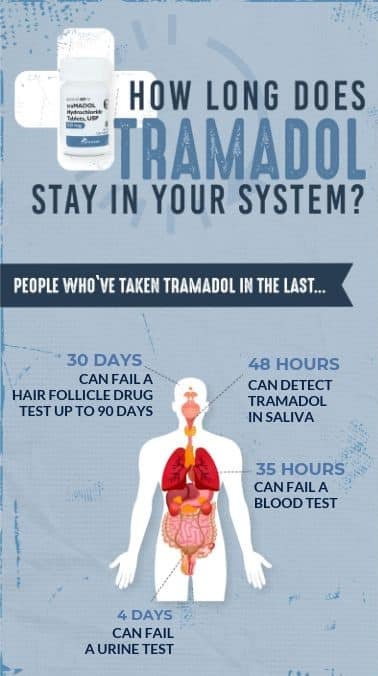How long tramadol stays in your system is different for each person and depends on several factors. Different drug tests also detect tramadol within different time windows.

Tramadol reaches its peak concentration in the body in abouttwo to three hours. The drug’s half-life, or how long it takes for half of it to be cleared from your body, is6.3 hoursfor a single dose andaround seven hoursfor multiple doses. However, it can take abouta day and a halffor the drug to completely leave the body.
Tramadol can be detected in the urine, hair, saliva, and blood:
- Inurine, tramadol can be detected for up to4 days.
- Inhair, tramadol can be detected for at least30 days.
- Insaliva, tramadol can be detected for up to2 days.
- Inblood, tramadol can be detected for up to35 hours.This is based on the drug’s half-life, as it takes an estimatedfive half-livesfor the drug to be cleared from your body.
The amount of time it takes for tramadol to leave the body can depend on factors like sex, age, organ function, liver enzyme activity and more.
Approximately2 millionpeople in the United States suffer from substance misuse related to opioids. One opioid prescription is tramadol, a medication that can be detected in the body through several testing methods. To understand how this testing works, it is important to understand what tramadol is and how it affects the body.
Tramadol’s Half-Life
How long tramadol will stay in the body is based primarily on the medication’s elimination half-life, or the average amount of time it takes for half of the drug to be cleared from the body. Tramadol’s half-life is 6.3 hours for a single dose and around 7 hours for multiple doses. As it takes an estimated five half-lives for a drug to be eliminated from the body, it can take around 35 hours for tramadol to be cleared from your system.
However, this varies depending on the person and numerous factors.
Factors that Influence How Long Tramadol Stays in the Body
Sex
Men and women often process drugs differently due to physiological differences. The peak tramadol concentration in women is about12%higher than in men. For this reason, tramadol may stay in a woman’s body longer than in a man’s.
Age
The half-life of tramadol is believed to increase toseven hoursin people over aged 75. Further, tramadol can reach higher concentrations in the blood in people of this age group. As a result, tramadol may stay in an older person’s body longer than in a younger person’s.
The function of the Body’s Organs
Before tramadol leaves the body, it is metabolized by enzymes in the liver and processed through the kidneys. If either the liver or the kidneys are not functioning correctly, tramadol and its metabolites may take longer to be broken down by the body than they would with healthy liver and kidney function.
Liver Enzyme Activity
Your liver creates an enzyme called CYP2D6, which plays a large role in breaking down tramadol. However, different people have different levels of CYP2D6 activity. Around7%of Caucasian people have CYP2D6 enzymes that are less active than normal as a recessive trait, and doctors refer to these people as “poor metabolizers.” If you are a poor metabolizer of CYP2D6, tramadol will take longer than expected to be cleared from your body. Conversely, if your CYP2D6 enzyme is more active than normal, you may be a “rapid metabolizer” or “ultra-rapid metabolizer.” In these cases, tramadol may be cleared from your body more quickly than expected. Doctors can perform blood tests to determine how active your CYP2D6 is.
Dosage of Medication
The amount of tramadol a person is taking can affect how long the medication will remain in their body. Someone taking a high dosage of the drug will take longer to clear the drug than a person taking a lower dose.
Type of Medication and Time Taking It
Tramadol comes in two forms – an immediate release, which releases the full amount in the body and acts quickly, or an extended-release, which works over 24 hours and releases the medication a little bit at a time. Someone taking the extended-release type of medication will take longer to clear it from the system since it is being released over a longer period of time. Additionally, someone who has only been on the medication a short amount of time will be able to rid the body of it more quickly than someone who has been taking it regularly for a long period of time. This is because the drug will have had less time to build up in the body.
Use of Other Drugs
Certain drugs can affect the rate at which the body metabolizes tramadol, which is why it’s important to talk to your doctor before using numerous medications at one time. Some drugs that can increase the amount of tramadol in your bloodstream and how long it lasts in your bodyinclude:
- Fluoxetine, sold under the brand name Prozac
- Amitriptyline
- Quinidine
Types of Testing for Tramadol
Tramadol will not be detected on a typical drug screening, known as a SAMHSA-5 panel. However, it will show up on more advanced testing if someone decides to test for prescription drugs. Such advanced tests include urine tests, hair tests, saliva tests and blood tests.
Urine Tests
A urine test involves collecting a urine sample from an individual. Once collected, the urine will be sent to a lab to be tested for tramadol, but more specifically for its metabolites, which is the substance created when the body breaks down a drug. Typically, tramadol can be detected for up to4 days.
Hair Tests
When a hair test is administered, hair follicles are collected from an individual’s head and are sent to a lab for testing. Hair testing is a very accurate method of detecting tramadol and its metabolites, so it is often utilized. It is also a testing method that can detect tramadol use long after it occurs, sometimes for months afterward. One study showed that tramadol can be detected for at least30 daysin hair.
Saliva Tests
A saliva sample is taken from an individual’s mouth and screened for tramadol and its metabolites. It is detectable for up to2 daysusing a saliva test.
Blood Tests
Blood tests aren’t often utilized since they are invasive and tramadol use isn’t detectable in the blood for a long period of time. Tramadol can be detected for up to 35 hours in blood, roughly.
Though this information is a good starting point, it is important to remember that every individual’s body will process drugs differently. What may take hours to clear one person’s system could take days for another person, which is why it’s important to consider additional factors to determine how long a drug will take to clear the body.
















